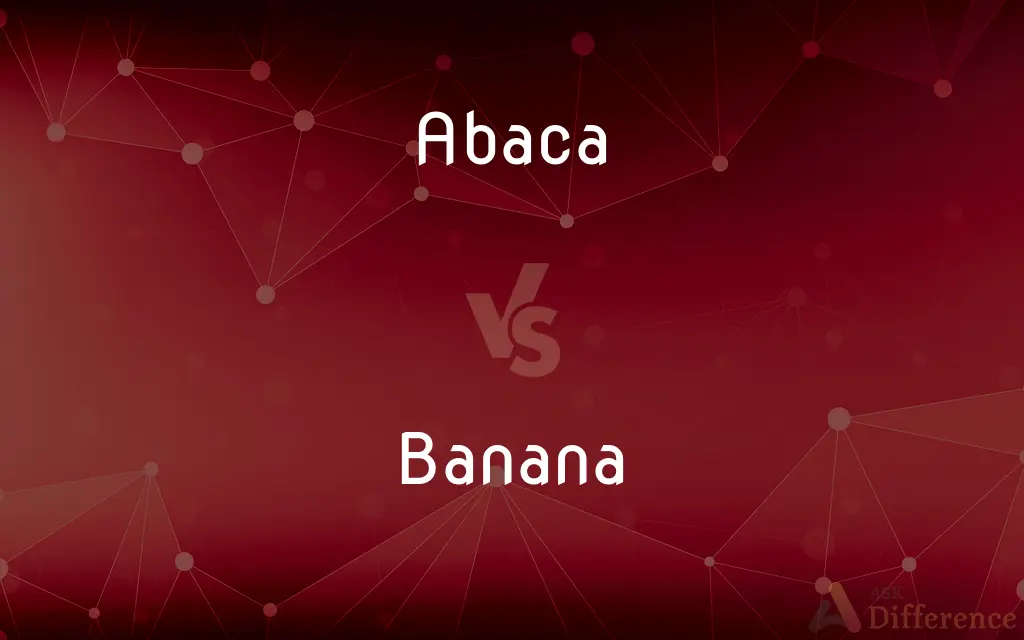Abaca vs. Banana — What's the Difference?
By Urooj Arif & Maham Liaqat — Updated on March 11, 2024
Abaca, a fiber from the banana family, is used in making ropes, while bananas are popular, edible fruits.

Difference Between Abaca and Banana
Table of Contents
ADVERTISEMENT
Key Differences
Abaca is a species of banana known for its strong fiber, extracted from the leaf sheaths, primarily used in making ropes, textiles, and other materials. Whereas bananas are cultivated for their soft, edible fruit that is a staple in diets worldwide.
The cultivation of abaca is focused on its fibrous aspect, suitable for industrial use in ropes, tea bags, and currency paper, highlighting its durability and strength. On the other hand, bananas are grown for their nutritional value, providing essential vitamins and minerals, and their versatility in culinary uses.
Abaca plants are generally taller and more fibrous, making them less suitable for direct consumption. Whereas banana plants produce fruit that is widely consumed fresh or used in cooking, desserts, and smoothies.
The environmental conditions for growing abaca include humid, tropical regions with plenty of rainfall, optimizing fiber yield. On the other hand, bananas thrive in similar climates but are more sensitive to wind and require careful management to ensure fruit production.
Harvesting abaca involves extracting the fiber from the leaf sheath, a labor-intensive process that yields a material known for its strength and resistance to saltwater. In contrast, harvesting bananas involves waiting for the fruit to ripen, focusing on the timing to ensure sweetness and texture.
ADVERTISEMENT
Comparison Chart
Primary Use
Making ropes, textiles, and paper
Consumed as food
Part Used
Leaf sheaths for fiber
Fruit
Cultivation
Fiber production, more fibrous, taller
Food production, more sensitive to wind
Environment
Humid, tropical, high rainfall
Humid, tropical, sensitive to conditions
Harvesting Process
Extracting fiber, labor-intensive
Waiting for fruit to ripen, timing crucial
Compare with Definitions
Abaca
Known for its strong, durable fiber.
Abaca fiber is preferred for marine ropes due to its saltwater resistance.
Banana
A fruit that is widely consumed worldwide.
Bananas are a popular snack for people on the go.
Abaca
Used in eco-friendly products, including textiles and paper.
Abaca paper is both sustainable and durable.
Banana
Used in various culinary dishes.
Bananas add sweetness and moisture to banana bread.
Abaca
The plant resembles a banana plant but is primarily non-edible.
Despite looking similar to banana plants, abaca is not grown for its fruit.
Banana
Rich in vitamins and minerals.
Eating a banana can provide a quick energy boost.
Abaca
A tropical plant whose fiber is used in making ropes.
The bridge uses abaca fiber for its suspension cables.
Banana
Cultivated in tropical and subtropical regions.
Banana plantations are common in Central America.
Abaca
Cultivated primarily in the Philippines and Ecuador.
The Philippines is a leading exporter of abaca fiber.
Banana
Available in different varieties, from sweet to starchy.
Plantains, a type of banana, are used in cooking rather than eaten raw.
Abaca
A bananalike plant (Musa textilis) native to the Philippines and having broad leaves with long stalks.
Banana
A banana is an elongated, edible fruit – botanically a berry – produced by several kinds of large herbaceous flowering plants in the genus Musa. In some countries, bananas used for cooking may be called "plantains", distinguishing them from dessert bananas.
Abaca
The fibers obtained from the stalks of this plant, used to make cordage, fabric, and paper. Also called manila, Manila hemp.
Banana
Any of several treelike plants of the genus Musa, especially M. acuminata, having a terminal crown of large, entire leaves and a hanging cluster of fruits.
Abaca
Musa textilis, a species of banana tree native to the Philippines grown for its textile, rope- and papermaking fibre.
Banana
The elongated, edible fruit of these plants, having a thick yellowish to reddish skin and whitish, pulpy flesh.
Abaca
(uncountable) The fiber of this plant, used in rope, fibers, and cloth
Banana
An elongated curved tropical fruit of a banana plant, which grows in bunches and has a creamy flesh and a smooth skin.
Abaca
The Manila-hemp plant (Musa textilis); also, its fiber. See Manila hemp under Manila.
Banana
In particular, the sweet, yellow fruit of the Cavendish banana cultivar, which may be eaten raw, as distinct from e.g. a plantain for cooking.
Abaca
A kind of hemp obtained from the abaca plant in the Philippines
Banana
The tropical tree-like plant which bears clusters of bananas, a plant of the genus Musa (but sometimes also including plants from Ensete), which has large, elongated leaves.
Abaca
Philippine banana tree having leafstalks that yield Manila hemp used for rope and paper etc
Banana
(uncountable) A yellow colour, like that of a banana's skin.
Banana
A person of East Asian descent, especially an ethnic Chinese from a Western country who does not speak Chinese and only speaks English, considered to have overly assimilated and to be subservient to white authority, an East Asian race traitor.
Banana
(slang) The penis.
Banana
(sports) A banana kick.
Banana
(nuclear physics) A banana equivalent dose.
Banana
A catamorphism (from the use of banana brackets in the notation).
Banana
Curved like a banana, especially of a ball in flight.
Banana
A perennial herbaceous plant of almost treelike size (Musa sapientum); also, its edible fruit. See Musa.
Banana
Any of several tropical and subtropical treelike herbs of the genus Musa having a terminal crown of large entire leaves and usually bearing hanging clusters of elongated fruits
Banana
Elongated crescent-shaped yellow fruit with soft sweet flesh
Common Curiosities
Can you eat abaca?
No, abaca is not cultivated for edible purposes; it's grown for its fibrous material.
Are abaca and bananas grown in similar climates?
Yes, both thrive in humid, tropical regions with ample rainfall.
What nutritional benefits do bananas offer?
Bananas are rich in potassium, vitamin C, and dietary fiber.
What is abaca used for?
Abaca is primarily used for making ropes, textiles, and specialty paper.
How are bananas used in cooking?
Bananas are used in desserts, smoothies, and savory dishes for their sweet flavor and texture.
Why is abaca fiber so strong?
Abaca fiber is naturally resistant to saltwater and damage, making it ideal for durable goods.
Can bananas be used in non-culinary ways?
Yes, banana peels can be used in gardening as fertilizer and for polishing leather and silver.
What distinguishes abaca plants from banana plants?
Abaca plants are taller, more fibrous, and mainly used for their fiber, not their fruit.
How is abaca harvested?
The fiber is extracted from the leaf sheath in a labor-intensive process.
What are the main products made from abaca?
Ropes, tea bags, textiles, and specialty papers are the main products.
What are the environmental requirements for growing abaca?
Abaca requires humid, tropical climates with plenty of rainfall and is somewhat tolerant of poor soil.
How often do banana plants bear fruit?
Banana plants bear fruit once per plant, after which they are typically replanted.
Are there different types of abaca?
Yes, there are several types of abaca, but they are primarily distinguished by fiber quality rather than fruit.
Is abaca eco-friendly?
Yes, abaca is considered eco-friendly due to its sustainability and biodegradability.
How long does it take for a banana plant to produce fruit?
It usually takes about 9 to 12 months for a banana plant to produce fruit after planting.
Share Your Discovery

Previous Comparison
Sap vs. Sip
Next Comparison
Investigate vs. ResearchAuthor Spotlight
Written by
Urooj ArifUrooj is a skilled content writer at Ask Difference, known for her exceptional ability to simplify complex topics into engaging and informative content. With a passion for research and a flair for clear, concise writing, she consistently delivers articles that resonate with our diverse audience.
Co-written by
Maham Liaqat












































